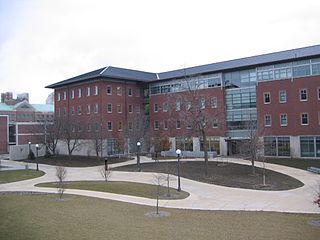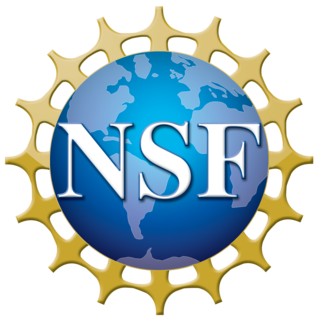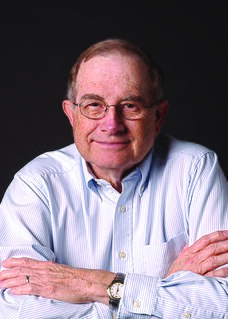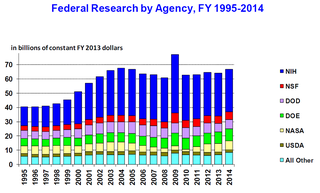Related Research Articles

The National Center for Supercomputing Applications (NCSA) is a state-federal partnership to develop and deploy national-scale cyberinfrastructure that advances research, science and engineering based in the United States. NCSA operates as a unit of the University of Illinois Urbana-Champaign, and provides high-performance computing resources to researchers across the country. Support for NCSA comes from the National Science Foundation, the state of Illinois, the University of Illinois, business and industry partners, and other federal agencies.

The National Science Foundation (NSF) is an independent agency of the United States government that supports fundamental research and education in all the non-medical fields of science and engineering. Its medical counterpart is the National Institutes of Health. With an annual budget of about $8.3 billion, the NSF funds approximately 25% of all federally supported basic research conducted by the United States' colleges and universities. In some fields, such as mathematics, computer science, economics, and the social sciences, the NSF is the major source of federal backing. In 2016, there were 6.9 million scientists and engineers employed in the United States. The 2020 NSF budget, split per capita, amounts to $1200 per US scientist per year; hence, it is not a practical funding source for most scientists.

The National Superconducting Cyclotron Laboratory (NSCL) is located on the campus of Michigan State University and is the leading rare isotope research facility in the United States. Established in 1963, the cyclotron laboratory is the nation's largest nuclear science facility on a university campus. Funded primarily by the National Science Foundation and MSU, the NSCL operates two superconducting cyclotrons. The lab's scientists investigate the properties of rare isotopes and nuclear reactions. In nature, these reactions would take place in stars and exploding stellar environments such as novae and supernovae. The K1200 cyclotron is the highest-energy continuous beam accelerator in the world.
The National Institute of Mental Health (NIMH) is one of 27 institutes and centers that make up the National Institutes of Health (NIH). The NIH, in turn, is an agency of the United States Department of Health and Human Services and is the primary agency of the United States government responsible for biomedical and health-related research.
The Small Business Innovation Research program is an American government program, coordinated by the Small Business Administration, intended to help certain small businesses conduct research and development (R&D). Funding takes the form of contracts or grants. The recipient projects must have the potential for commercialization and must meet specific U.S. government R&D needs.

A grant is a fund given by an end entity grant – often a public body, charitable foundation, or a specialised grant-making institution – to an individual or another entity for a specific purpose linked to public benefit. Unlike loans, grants are not to be paid back.

Medical research, also known as experimental medicine, encompasses a wide array of research, extending from "basic research", – involving fundamental scientific principles that may apply to a preclinical understanding – to clinical research, which involves studies of people who may be subjects in clinical trials. Within this spectrum is applied research, or translational research, conducted to expand knowledge in the field of medicine.

Arden Lee Bement Jr. is an American engineer and scientist and has served in executive positions in government, industry and academia.

The National Science Board (NSB) of the United States establishes the policies of the National Science Foundation (NSF) within the framework of applicable national policies set forth by the President and the Congress. The NSB also serves as an independent policy advisory body to the President and Congress on science and engineering research and education issues. The Board has a statutory obligation to "...render to the President and to the Congress reports on specific, individual policy matters related to science and engineering and education in science engineering, as Congress or the President determines the need for such reports,". All Board members are presidential appointees. NSF's director serves as an ex officio 25th member and is appointed by the President and confirmed by the US Senate.

Cornelius Francis "Neal" Lane, is a U.S. physicist and Senior Fellow in Science and Technology Policy at Rice University's Baker Institute for Public Policy and Malcolm Gillis University Professor Emeritus of Physics and Astronomy Emeritus at Rice University in Houston, Texas.
In many countries, the term principal investigator (PI) refers to the holder of an independent grant and the lead researcher for the grant project, usually in the sciences, such as a laboratory study or a clinical trial. The phrase is also often used as a synonym for "head of the laboratory" or "research group leader". While the expression is common in the sciences, it is used widely for the person or persons who make final decisions and supervise funding and expenditures on a given research project.

Data sharing is the practice of making data used for scholarly research available to other investigators. Many funding agencies, institutions, and publication venues have policies regarding data sharing because transparency and openness are considered by many to be part of the scientific method.
The United States National Academy of Sciences' Board on Science, Technology, and Economic Policy (STEP) is a board of the United States National Academy of Sciences.
The America Creating Opportunities to Meaningfully Promote Excellence in Technology, Education, and Science Act of 2007 or America COMPETES Act was authored by Bart Gordon and signed by President George W. Bush; it became law on 9 August 2007. This was an Act, "To invest in innovation through research and development, and to improve the competitiveness of the United States."

Maxine Frank Singer is an American molecular biologist and science administrator. She is known for her contributions to solving the genetic code, her role in the ethical and regulatory debates on recombinant DNA techniques, and her leadership of Carnegie Institution of Washington. In 2002, Discover magazine recognized her as one of the 50 most important women in science.

The science policy of the United States is the responsibility of many organizations throughout the federal government. Much of the large-scale policy is made through the legislative budget process of enacting the yearly federal budget, although there are other legislative issues that directly involve science, such as energy policy, climate change, and stem cell research. Further decisions are made by the various federal agencies which spend the funds allocated by Congress, either on in-house research or by granting funds to outside organizations and researchers.
A data management plan or DMP is a formal document that outlines how data are to be handled both during a research project, and after the project is completed. The goal of a data management plan is to consider the many aspects of data management, metadata generation, data preservation, and analysis before the project begins; this may lead to data being well-managed in the present, and prepared for preservation in the future.
The White House BRAIN Initiative, is a collaborative, public-private research initiative announced by the Obama administration on April 2, 2013, with the goal of supporting the development and application of innovative technologies that can create a dynamic understanding of brain function.
NIH Office of Science Policy is the primary advisor to the Director of the NIH on matters of biomedical research policy issues that are of significance to the agency, the research community, and the public. The office also works with stakeholders within and outside of NIH to develop policies that promote progress in the life sciences. The current NIH Associate Director for Science Policy is Carrie D. Wolinetz, Ph.D.
Bianxiao Cui is the current Job and Gertrud Tamaki Professor of Chemistry and a fellow of the Stanford Neuroscience Institute at Stanford University.
References
- ↑ "Austin, F.C. (2008). High-Risk High-Reward Research Demonstration Project, presentation given to the NIH Council of Councils" (PDF).
- ↑ "National Science Board Approves NSF Plan to Emphasize Transformative Research". www.nsf.gov.
- ↑ Arden L Bement Jr. "Transformative Research: The Artistry and Alchemy of the 21st Century." Delivered on January. 4, 2007. This speech by Bement Jr. to the Texas Academy of Medicine, Engineering and Science sums up his perspective on both the need and the nature of transformative research.
- ↑ "AAAS (2008). "Advancing Research in Science and Engineering (ARISE): Investing in Early-Career Scientists and High-Risk, High-Reward Research." Cambridge, MA: American Academy of Arts and Sciences" (PDF).
- ↑ https://www.nsf.gov/nsb/publications/2011/meritreviewcriteria.pdf [ bare URL PDF ]
- ↑ "GPG Chapter III". www.nsf.gov.
- ↑ "CSID - Center for the Study of Interdisciplinarity". webarchive.library.unt.edu.